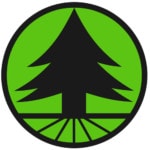Home » Tree Improvement
Category Archives: Tree Improvement
Why You Should Never Attempt Tree Removal on Your Own
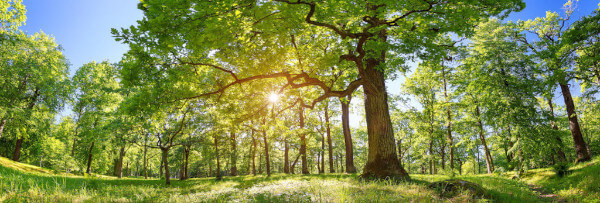
Never Attempt Tree Removal on Your Own
It’s estimated that urban trees have an average lifespan of around 20 years. Based on that number, you might think that tree removal is not something you will have to worry about anytime soon, especially if your trees are relatively newly planted.
But there are natural occurrences that might end your trees’ lives early, such as thunderstorms and tree diseases. In that case, you will need to be proactive and remove those dying or dead trees before they can affect the rest of your garden.
Do you currently have a tree that needs to be removed? In that case, you should call a professional!
You might think you can perform tree removal on your own, but the truth is, you should never try to. Read on to find out why.
Never Attempt Tree Removal Because: You Might Not Have the Right Equipment
When you consider removing a tree, you might think that all you need is a chainsaw and/or a hacksaw. Then, all you need to do is just get to work, right?
But the reality is, there’s proper commercial-grade equipment that the professionals use to perform tree removal services. Since you most likely do not have that type of equipment, you will not have the right tools for the job.
As a result, this can cause many other issues (which we will explore below).
Even if you were to get the right equipment, it can end up costing you a pretty penny. Not to mention, this rarely used equipment will take up precious space in your shed.
If you have professional tree surgeons come to perform tree felling, they’ll bring all the proper equipment with them, which can end up saving you money (and space) in the long run.
Never Attempt Tree Removal Because: The Tree Can Fall Incorrectly
Chances are, you are probably not a trained arborist. This means you do not have the training or experience to cut the tree, so it falls correctly.
Even if you have an inkling and grasp of some basic physics, you are still too inexperienced to confidently predict where a cut tree will land. This unpredictability can cause injury and damage to properties.
Professionals will know how to cut the tree in sections so that each bit will come off safely.
You Might Hurt Yourself
There are so many aspects of a tree removal service that can potentially go wrong. And when they do, you will be the one paying for it.
As we have said above, the tree can fall incorrectly, meaning it can land on any part of your body. Resulting injuries can be as small as cuts and bruises, and as serious as broken bones and punctured organs, or even death!
Also, just one wrong move with equipment (such as a chainsaw or hacksaw) can result in serious injuries. This may cost you a trip to the A&E.
Also, many homeowners who take on DIY projects often do not wear the correct personal protective equipment (PPE). Things like safety glasses, hardhat, gloves, sturdy shoes, and long-sleeved clothing will help decrease the chances of injury. But unfortunately, most do not think to wear these items.
Lastly, for some trees, you might need to get up high to cut certain branches. Standing at any height can result in a serious fall if you do not secure yourself properly. This can also end up with cuts, bruises, and broken bones.
You Might Cause Damage to Property
Returning to the possibility of the tree falling incorrectly if you are lucky, it will just fall on your lawn, without damaging much else.
But in the worst-case scenario, the tree might end up crashing onto your other plants, car, garage, or home. Even worse, it might cross property lines and destroying your neighbour’s property!
Avoid all this trouble and get peace of mind by using a professional instead. Not only can they perform correct tree felling, but they will also have insurance to cover any damages should anything unfortunate happen.
You Won’t Be Able to Remove the Tree Completely on Your Own
Whilst some homeowners choose to keep the end stump in the ground, many others opt to have it removed as well. This will require the proper knowledge and skills to completely remove the entire stump and surface roots.
Not only that, but you will also need specialised equipment like a stump grinder. Again, you probably do not have this equipment lying around, which means you would need to go through the hassle of buying these things. Hiring a professional for tree stump removal is a lot easier and safer.
Other Benefits of Using a Professional
The main reason for using a professional for tree removal services is this: safety. Not only will you protect yourself and others around, but also, the surrounding property.
But this is not the only benefit you will reap from using a professional.
Besides, they will provide complete services, meaning they will also clean up your property afterwards. You will not have to worry about having a garden strewn with random branches.
Not only will you remain safer by opting for a professional, but you will also save some time. When you consider the tree removal cost, it will be well worth it when you consider how long it would take you to attempt removing a tree on your own.
Do You Require Tree Removal Services? Then Call a Professional
As you can see, if you need tree removal carried out, you should not attempt to do it on your own. Not only is it dangerous to you, others, and your property, but it will probably be time-consuming for you as well because you might not have the right equipment.
So, the next time you have a dead or downed tree, call a professional instead. They will be able to remove your tree safely, so you do not have to lift a finger at all. Plus, it will be a cost-effective way to keep your garden beautiful and healthy.
Are you looking for “tree removal service near me”? Then contact GraftinGardeners now. We will get you a free quote promptly!
Article was written by Conner D.
Article Source: https://www.graftingardeners.co.uk/never-attempt-tree-removal/
What’s the difference between tree lopping and tree pruning?
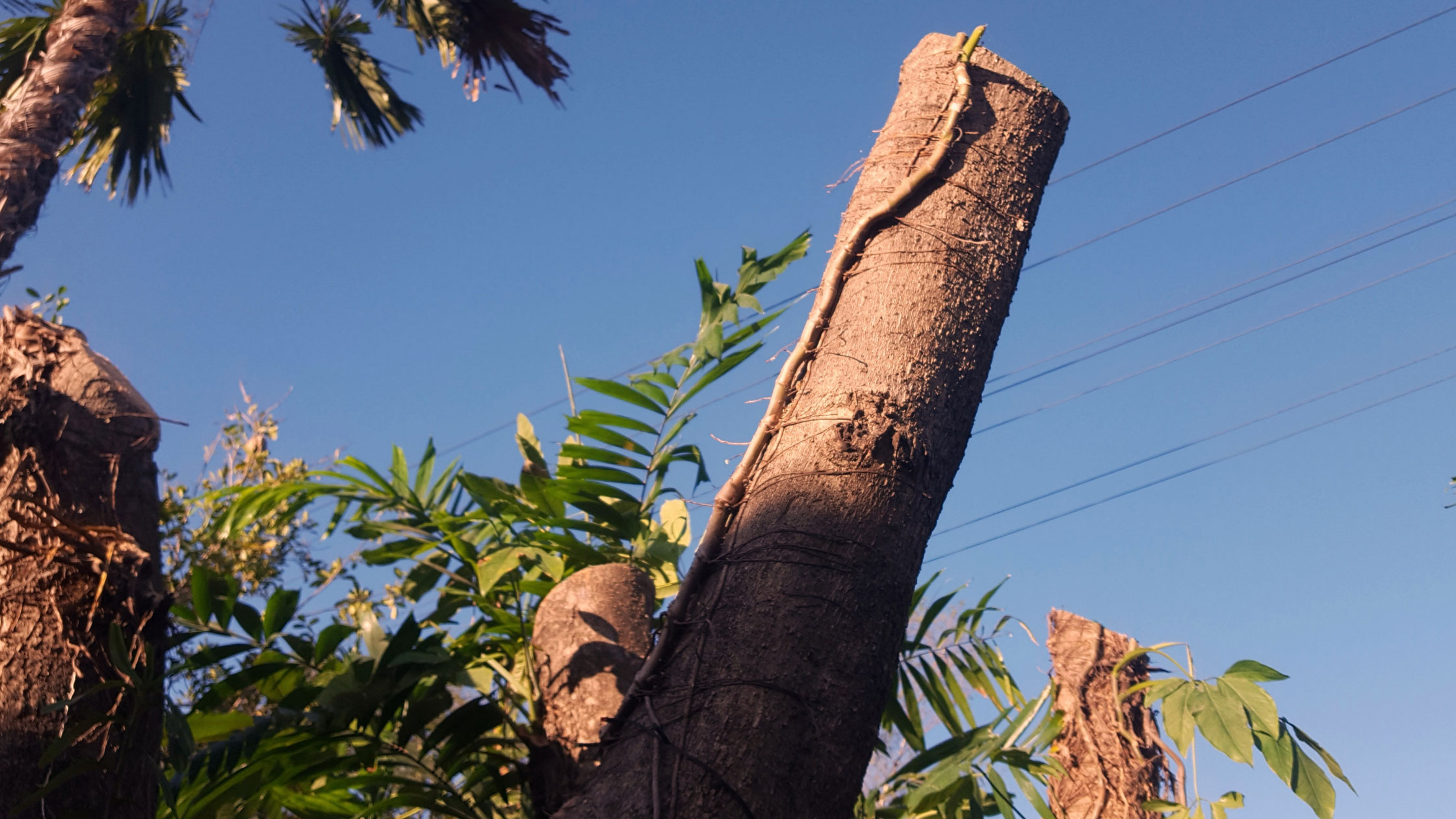
Each service provides a different level of care for your tree
For the average Aussie, there can be confusing terms for tree care services. Some of these terms mean the same thing and some mean something completely different. When you’re ordering a tree care service it’s important to know exactly what you’re getting. A good tree care specialist will take the time to assess your tree and recommend the best service for it. They could recommend you a tree lopping or tree pruning service. It all depends on the condition of your tree.
Tree care specialists like Arborists will recommend a service depending on the health of your tree. A tree may be so unhealthy that they may recommend a service to completely remove it from your yard. This is usually the point of no return. This removal option is a last resort when they have identified that the tree has no realistic chance of regaining its health. An unhealthy tree also poses a safety risk. An arborist will recommend a tree removal service to help make your yard and home safe from a tree that could fall down.
So what is tree lopping?
Tree lopping is a dangerous practice because when the tree has new growth these branches are poorly attached to the tree.
As these branches grow bigger and heavier they are more likely to break and fall off. This can eause injury & death or property damage.
After Tree Lopping, your tree may also be vulnerable to diseases and decay. The wounds of the tree are not sealed. When wounds are not sealed with a proper solution they are more vulnerable to pests and other forms of decay.
This is why Daryl’s Tree Care does not recommend tree lopping under any circumstances. Instead, we follow the guidelines set out in the Australian Standards 4373-2007 “Pruning of Amenity Trees”.
Why tree pruning is a healthier and safer alternative
Compared to Tree Lopping, Tree Pruning is a safer option for a number of reasons. Tree Pruning is designed to help a tree fight off diseases and pests. This technique is also undertaken to sustain and even prolong the life of a tree. AS with any other tree care service, Pruning requires the skills and knowledge of a professional.
A professional Arborist will assess your tree’s need for a pruning service based on its health, safety requirements and appearance. If the health of your tree is too poor an Arborist may even recommend removing your tree completely. A Tree Pruning service is what you should rely on if you’re looking to extend the life of your tree. It’s the go-to option for improving the health of your tree. Health benefits of Tree Pruning can include the following:
- Encourages fruit production
- Provides more aeration
- Take control of pests and diseases
- Enabling more sunlight for photosynthesis
With optimum tree health comes the added benefits of safety. The healthier a tree is, the less chance there is of tree branches becoming weak and falling off. Weak and brittle branches can fall off and cause extensive damage to backyard features including other trees and fences. Large and heavy branches can also fall off and at the very least, cause costly damage to your home or neighbouring properties.
Choosing the right tree pruning service
With so many professional tree care services out there it’s hard to know which one to pick. You can go off local recommendations and customer reviews. But sometimes you don’t always have that option. One way to pick a professional tree care service is to assess their credentials. Your arborist should be certified along with having insurance such as work cover and public liability.
Qualified arborists will follow the guidelines in Australian Standards 4373-2007 “Pruning of Amenity Trees”. There are many techniques involved with Tree Pruning and your Arborist should be well versed in all of them to provide an extensive service for you. These techniques include canopy thinning, crown reduction, dead-wooding, weight reduction and crown lifting.
Start taking better care of your trees today
Here at Daryl’s Tree Care, we offer a wide range of tree care services for all your needs. We understand how the health of your tree can affect your entire backyard. Our Tree Pruning Service can take care of all your concerns when it comes to the health and safety of your tree. All of our Arborists are certified,(or near) experienced and fully insured for the tasks they perform. Call us today on 9897 4418 or send an enquiry via our contact page to get a free quote on Tree Pruning in your backyard.
The post What’s the difference between tree lopping and tree pruning? appeared first on Daryl's Tree Care And Surgery.
5 things to look for when choosing a tree removal service
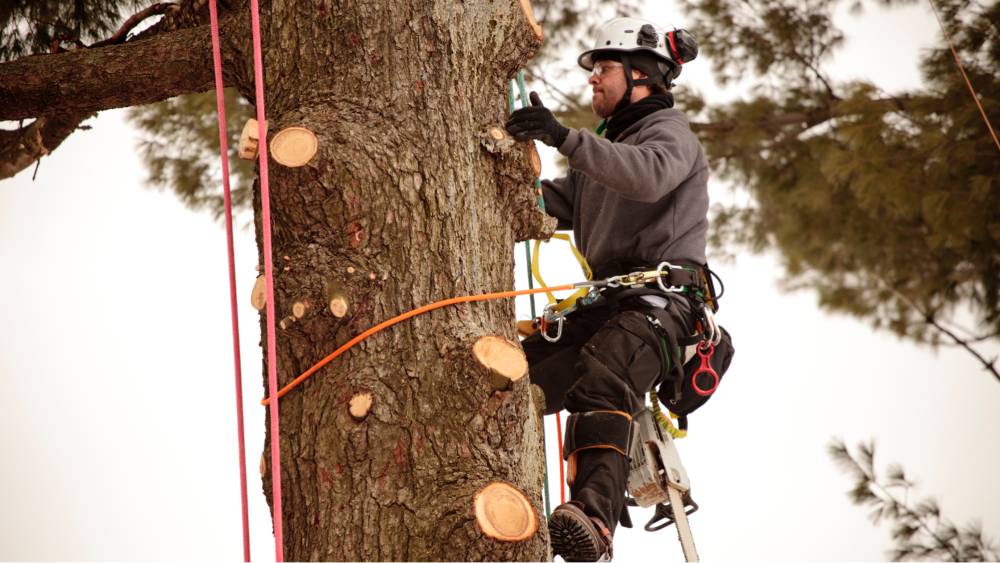
Don’t book a local Tree Removal Service unless they have these credentials
Growing trees is a lovely way to liven up your backyard. It can help clean the air around you and attract local wildlife. But without careful maintenance, your tree can become overgrown and start causing issues. Large roots can lift up pavers and concrete. Excess leaves can clog your gutters and weak branches can fall and cause damage to your house.
You can try cutting down your tree but it takes a lot of tools and knowledge to get it done right. If you’re cutting branches from up high it can be dangerous to reach them. You need the right ladders and safety gear. A safer and more efficient alternative is to book a local Tree Removal service.
A Tree pruning service is used to modify the shape of your tree. With the careful cutting of branches, a tree can be trained to grow in a certain direction. Damaged or dying sections of a tree are usually removed to promote better growth and health. These are the types of services you can expect from a professional Arborist.
Now that you know what a Arborist does, how do you decide which one to choose? One of the first things you need to know is what to look out for in a Arborist service. If you would like to know what they are then read on to find out.
Insurance
No matter what home service you rely on at home it should always have decent insurance cover. Because no matter how organised or safe a business is, there is always the chance of something going wrong. Insurance will help cover the damage caused by anything that happens to your property during a Tree Removal or Pruning service.
So when you’re checking out the website of a local Arborist, have a look at their credentials. They should be fully insured to carry out work at your property. An Arborist should have public liability insurance, professional indemnity insurance, and work cover.
Reviews
Looking at reviews is one of the best ways to see how good a local service provider is. Your local Arborist might have the customer testimonials displayed on their own website. There are also many online platforms you can rely on to find reviews of a business such as Google Reviews, Yelp, and productreview.com.au just to name a few.
Finding positive reviews for an Arborist can give you more confidence that you’re making the right decision. Of course one of the best ways to get a review is by word of mouth. Ask someone you know personally as they are far more likely to give you a detailed and honest review.
Full-service options
Be wary of Tree companies that try to cut corners. An obvious sign of this is a service provider that can’t do everything associated with Trees. A good service provider should be able to inspect your tree, provide a free quote, carry out the Tree service and remove any debris that’s left behind.
If a Tree Company can’t offer all the services required for removing a tree then you’ll be forced to contact another service to finish the job. This can end up costing you more money than just getting one service provider to take care of everything.
Focus on safety
Tree Services can involve many elements of danger like working from heights. The risks involved in this profession can put you and the service provider in danger. That’s why it’s so important for a Tree Company to be using all the right safety equipment and practices.
You have every right to ask a Tree Company what safety measures will be in place during the job. This can help you identify how well they have evaluated your property, identified risks, and implemented measures to protect the property and everyone near it.
Are they certified?
Asking a Tree Company if they are certified is one of the best ways to check their credentials. You’ll find that many Tree Company are members of industry associations that they can only be a part of after receiving certification.
If your Tree Company is a member then it means they are officially recognised as professionals that meet industry standards and are up to date with current industry knowledge and regulations.
Call Daryl’s Tree Care & Surgery for local Tree Removal
Here at Daryl’s Tree Care, we offer a full range of Tree services. Our certified Arborists know what it takes to look after your tree and provide services such as Tree Removal, pest control, and hazardous tree assessment.
With the right equipment, our Arborists will carry out any Tree service under the safest conditions possible. For your peace of mind, we can provide certificates for public liability, plant and equipment, and work cover insurance. All of our staff are covered by work health and safety plans. Our vehicles and machinery are also covered by individual insurance policies.
So for Tree Services you can rely on, call Darryl’s Tree Care and Surgery on 9897 4418.
The post 5 things to look for when choosing a tree removal service appeared first on Daryl's Tree Care And Surgery.
The Best Tree for Your Garden and Climate
The Best Tree for Your Garden and Climate!
Did you know there are around 70 different species of trees found in the UK?
Trees are not only beautiful, but they provide height, shade, and structure to any garden or garden. They also offer shelter to wildlife and contribute to healthier, cleaner air.
Still, this does not mean that every tree is automatically suitable for your property. Before you can choose the best tree for your garden, there are a few practical considerations to review first.
How much space do you have for your tree? How can you choose a tree that is visually interesting throughout the year? And how can you select trees that will be helpful to the local environment?
In this post, we will consider some of the best small trees for gardens, as well as some of the best fast-growing trees. Let us get started!
The Best Trees for Your Garden: 7 Ideas to Consider
The UK’s record-setting 44-meter beech tree may look splendid in Newtimber Hill, but it is unlikely to fit in your backyard. To help you find a more appropriately sized tree, consider one of the following species.
1. Dogwood (Cornus Florida)
If you want a compact tree that displays dazzling seasonal colours, look no further than the dogwood. These beauties put out pink or white bracts each spring, followed by bright orange and red during the autumn.
Dogwoods are perfect for small gardens or gardens since many species max out around 3m in height. Set up a few patio chairs beneath the branches to enjoy semi-shade during the summer months.
2. Weeping Willow (Salix Babylonica)
It is hard to beat the natural beauty of the delicate weeping willow tree. Their signature low branches create lovely canopies that offer lots of shade year-round.
Weeping willows do well in wet locales, which is why you will often see them beside lakes or riverbanks. They grow quickly — anywhere from 1-2.5m per year — and max out around 15m tall.
There are other varieties to consider too, including the twisted willow, goat willow, or cricket bat willow.
3. Alder (Alnus Glutinosa)
Would you like to plant a native, eco-friendly tree that will attract plenty of birds and insects? Alders are among the most popular tree species for gardens and gardens, and for a good reason.
The Alder tree features clusters of cone-like fruits during the winter and yellow catkins in the springtime. These offer an early source of nectar and pollen for bees, while many species of birds feed on the seeds.
Alders grow fairly quickly and reach a height between 18-25m when mature. They favour moist conditions, making them ideal for London gardens and gardens.
4. Blackthorn (Prunus Spinosa)
If you have ever sipped on sloe gin, you are drinking the fruits of the blackthorn tree. This thorny tree provides visual interest throughout the year and is ideal for informal hedging.
In the early spring, you will enjoy the blackthorn’s white flowers. Later in the summer, the purplish “sloes” (fruit) begin to appear. Wait until after the first frost to pick them and then make your own sloe gin at home.
Blackthorn thrives in direct sunlight and will reach a height of 6-7m. Expect to see plenty of bees, caterpillars, magpies, and other animals feeding and nesting amongst the branches.
5. Crab Apple (Malus Sylvestris)
Crab apple trees have an interesting history that experts still cannot pinpoint. It is the wild ancestor of cultivated apple trees and has long been associated with fertility and love.
One thing everyone can agree on, however, is their beauty — especially during the springtime. Crab apple trees put out stunning pink and white blossoms each spring. Birds and small mammals (such as badgers) love the fruit, while bees are drawn to the nectar and pollen.
Crab apples usually grow to a height of 7-9m, although they can be kept smaller with proper pruning.
6. Silver Birch (Betula Pendula)
There is a seemingly endless variety of birch trees to choose from, but the silver birch may be the best tree for your garden. Their distinctive silver-white bark is impossible to miss, as are its dainty, triangular-shaped leaves.
The silver birch is especially beautiful in the autumn months when the leaves turn a bright gold colour. Small birds love the birch tree for its seed and the various insects it hosts.
Expect your silver birch tree to reach a height of 15-20m when fully mature. It thrives in acidic or sandy soils, although it can tolerate moist conditions as well.
7. Japanese Maple (Acer palmatum)
Although not native to the UK, it is hard to argue the striking beauty of the Japanese maple tree. They are slow-growing and graceful, with translucent leaves that shimmer in the sunlight.
Most varieties feature a spectacular array of colours during the year, with rich reds, oranges, and purples common during the autumn. They thrive in the shade and grow well with ferns and other moisture-loving plants.
Japanese maples vary greatly in size, depending on the exact species. Dwarf maples are smaller than 1m in height, while larger varieties may reach 10m or more. If you have your heart set on a Japanese maple, you can find a varietal that will fit nicely in your garden.
Which Is the Best Tree for Your Garden?
The type of tree you plant in your garden is a big decision. After all, with proper maintenance and care, the tree will be there for many decades to come!
So then, which of the species listed above is the best tree for your garden? Use these suggestions to help you choose a tree that will complement your home and help the environment at the same time.
Now that you know the best trees for your front garden, the only thing left to do is plant them. You might be tempted to DIY, but this is a job best left to the pros.
Grafting Gardeners provides tree planting services for properties across London and Surrey. Find out more here or give us a call at 0208 123 7653 to ask us a question.
Article was written by Conner D.
Article Source: https://www.graftingardeners.co.uk/the-best-tree/
Killing Your Trees: 6 Things You Don’t Even Realize You’re Doing to Kill Your Trees
Killing Your Trees.
Did you know that most trees live up 50-100 years on average? The famous red cedar from Alaska can live up to 3,500 years under the right environmental circumstances.
But how to care for trees in your backyard? What can you do and what you should not do to protect your beloved trees? This article discusses a few things that you should avoid when it comes to caring for your trees, so keep reading.
Killing Your Trees: 1. Putting Mulch Too Close to the Tree
Adding mulch to the base of the tree is the right thing to do, whether you have a young or mature tree. However, make sure that the mulch is not too close to the tree trunk because this might cause suffocation.
Expert gardeners recommend adding mulch approximately 6 inches away from the tree trunk. At the same time, you should keep the mulch about one foot away from the trunk of a mature tree. This ensures proper ventilation and prevents the tree trunk from suffocating during hot summer days.
Killing Your Trees: 2. Tying the Dog to Your Tree
Many homeowners have dogs in their yard. Most of these dogs live in dog houses, but sometimes you might see a dog owner tying his pet to a tree. This is done for various reasons and it might appear to be a harmless thing to do.
However, dogs will rarely just sit there and do nothing for hours on end. A dog will eventually pull and tug at the tree. In this case, the dog can cause significant damage to the tree bark. Remember that the tree bark is one of the most important defence mechanisms of a tree.
Even minor damage to the tree bark can predispose your shrub to attacks from pests. Therefore, make sure that you do not tie your dog to a tree and your dog will probably be happier too. This piece of advice is true regardless of the type or age of your tree.
Killing Your Trees: 3. Putting Concrete in Tree Cavities
This is another bad habit that could damage the health and wellbeing of your tree. In some cases, trees might develop cavities, and this can predispose them to diseases and pests. Some homeowners think that it is a good idea to pour concrete in tree cavities to fill them up and protect the tree.
This is bad because most trees will heal themselves if you give them enough time. Adding concrete is like introducing a foreign substance into your body. It can cause problems and there is no easy way to ever remove the concrete from the tree cavities in the future.
If your tree develops cavities, just make sure that you protect it against pests or wildlife animals that might cause it harm. Young trees especially will heal themselves and fill up these cavities in a few weeks under the right conditions.
4. Hammering Nails or Screws to the Tree
Homeowners might do this for various reasons. For example, some of them might try to hang bird feeders from a tree. Others pick a large tree and attempt to build a large treehouse to entertain their kids.
Although these are not bad things to do, adding nails or screws to a tree can seriously damage its health. It is like having a metal piece in your body. The nails might cut through vital areas of your tree, disrupting the flow of nutrients, slowing down the growth of a tree, and predisposing it to diseases.
Even if you try to go for smaller nails, the situation is the same. Any foreign object or substance forced inside a tree will affect its health. If you want to hang bird feeders, hang them on a sturdy branch without using nails or screws.
5. Planting Trees Around Power Lines
Electricity companies never liked the combination of power lines and trees. You never know when a storm can push the branches of a tree into the power lines and cause serious damage. On top of that, an entire street might remain without electricity and this can cause a lot of frustration and anger.
Ideally, you should keep power lines in mind when planting trees. Avoid putting a tree under an important electricity hub and try to guess how tall a tree might grow when it is fully matured. If you already have trees that are dangerously close to power lines, consider trimming their branches.
Not only branches can get entangled on power lines, but wildlife animals residing in trees can also cause problems. Adventurous squirrels can easily jump from a tree on a power line and get fried. They might cause a blackout at the same time as well.
6. Adding Salt Near the Tree
It is a common practice to add salt on the streets in winter times. This prevents skidding and slipping, especially when it snows too much, and the temperatures drop suddenly. However, salt close to your trees can be a real problem in the spring.
Keep in mind that salty soil does not allow the growth of plants, grass, and trees. A soil that has absorbed salt is virtually toxic for every organic matter. If you plan to add salt to your driveways and walkways, make sure that you avoid adding it too close to the roots of your trees.
If your local authorities are adding salt to the streets as a preventative measure, try to cover the areas surrounding your trees with a piece of cloth. This should prevent most of the salt from getting into the soil and jeopardize the wellbeing of your beloved trees.
Taking Care of Your Trees Can Raise Property Value
Yes, you read it right. Your trees are unbelievably valuable for your property and well-maintained ones can increase the value of your house. That is because they provide shade on hot summer days, improve air quality, and also add to your home’s curb appeal.
These are just a few tips on how to properly care for your trees and avoid significant damage in the long run. Make sure that you check out the other articles on our blog to learn more about different types of trees, how to care for them, and how to prolong their lifespan.
Article was written by Conner D.
Article Source: https://www.graftingardeners.co.uk/killing-your-trees/
Tree Pollarding 101
Tree Pollarding 101 – everything you need to know about pollarding.
If you are looking for ways to keep your landscape and trees looking their best, several key methods can make a huge impact on how your outdoor space looks.
A process called tree pollarding can help to create a lush, beautiful landscape that promotes healthy trees.
Read on to learn more about pollarding trees and what the process entails.
Tree Pollarding Defined
Most people likely have never heard of tree pollarding, but it is an important part of maintaining healthy trees. The process involves cutting young trees and shrubs to the main stem or trunk to control their height.
The plants are not cut at ground level but instead are cut much higher at an average height of around six feet. This process helps to maintain the desired height for your trees while reducing shade and giving the trees a defined silhouette.
Many people opt for tree pollarding to keep taller trees from getting in the way of phone lines or electrical wires. It is also done to trees located close to a home or place of business to reduce the risk of branches breaking and falling onto the roof.
While most typical tree pruning processes remove the lower and crossing limbs of a tree, the pollarding process is a bit different. Pollarding trees is often done when the tree is dormant rather than when it is actively growing. Doing this while a tree is still young or dormant promotes fuller, faster, and greener growth.
In addition to protecting wires, structures, and promoting better growth, tree pollarding may also reduce the risk of fungus and pests. It can also help to protect your trees from various diseases.
How to Pollard a Tree
To pollard a tree effectively, it is best to leave the job to the professionals. They will start by cutting off the central leader of the tree first, then proceed to cut all of the branches around it that are at the same height.
By cutting the top of the tree this way, it shortens the crown of the tree. The gardener will remove lower limbs and any crossing limbs to promote a thicker crown as it grows back.
The younger the tree, the faster the new growth will return, while older trees may take longer to regrow leaves and new branches. By pollarding large young deciduous trees, ensures that they sprout healthily to achieve fuller, greener, and lusher growth.
Once the procedure is complete, most trees will produce “waterspouts” at the various locations where it has been cut. These areas will produce sprouts that should be removed at least once per year or every other year. Eventually, knobs or knuckles will form at these locations and continue to regenerate each year.
The timing of tree pollarding is critical and should be performed during the tree’s dormant season. If the tree is pruned during its growing season, it can stunt the growth, remove its energy source, and inhibit the tree’s ability to re-sprout.
Most tree pollarding is done during the fall or winter months of the year when trees are losing their foliage. This is extremely important because most trees rely on their leaves to help produce energy for healthy growth during the warmer months of spring and summer. Removing sprouts and pollarding too early in the year can cause the tree to stop growing, or even worse – to perish.
A Tradition of Pollarding Trees
Tree pollarding originated in Europe centuries ago, and the original method was done to ensure that more abundant, smaller branches were produced. As a result, these smaller branches were removed and used as fuel or for making items such as woven baskets.
As the branches were consistently cut back, farmers would harvest the slender sprouts and use them as a food source for livestock. These slender sprouts were also utilized to help weave small fences and other structures.
Today, pollarding fruit trees is a popular method to ensure healthy growth. When the tree is pollarded correctly, it encourages more production of fruits for a bountiful harvest.
Many urban areas choose to pollard trees that line busy streets to help control their growth, preventing branches from falling onto power lines and roadways. Cutting trees back can keep them healthy while maintaining them at a smaller, more easily manageable size.
The difference between topping and pollarding trees is that tree pollarding produces large knuckles. These knuckles are the source of new growth each year and can help to ensure that the tree continues to grow healthy in the future. Imagine the knuckles on a tree as large scars that heal while new growth re-sprouts from dormant buds during the springtime.
Topping a tree does not lead to knuckle formation. This process cuts the entire top of the tree off, resulting in a large wound that can cause the tree to die. Ideally, pollarding fruit trees and other species is best to ensure a healthy outcome.
Pollarding: A Unique Technique
Whether you want to encourage healthy growth or remove threatening branches, tree pollarding is a wise way to go. This unique tree-pruning process will ensure that your trees look lush and beautiful for years to come.
Always consult with a professional arborist or landscaper if you are considering using tree pollarding as a method to ensure best results.
For more information about our services or to find out more, contact us today.
Article was written by Conner D.
Article Source: https://www.graftingardeners.co.uk/tree-pollarding-101/
Did you miss our previous article…
https://www.treesforeducation.com/?p=284
WHAT TO AVOID IN HIRING A TREE TRIMMER
So you’re in need for a tree service company? Our recent What to Look for in Hiring a Tree Trimmer guide is meant to highlight features of a tree contractor that are positives — aspects that you should look for in any company that you are considering working with. This article, on the other hand, is the opposite. It’s full of red flags! If any tree contractor has these features, then stop, and keep looking.
INCOMPLETE INSURANCE
People get insurance for their protection and also for others. The same goes for businesses. The first and top item on this list is to avoid tree contractors with incomplete or no insurance. What constitutes “complete” insurance? Due to the dangerous nature of the tree service industry, a combination of different insurances is needed to safely operate a company. But the two most vital ones are the following.
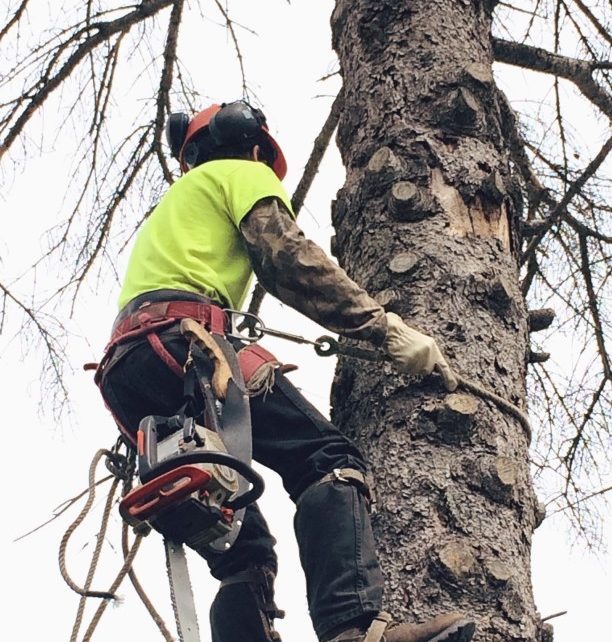 General Liability Insurance – This type of insurance is crucial for any tree service because it provides foundational business protection. It can cover property damage and bodily injury performed on jobs. Meaning, if a tree trimmer accidentally damages your roof, this is the insurance that would help with the repair. Without it, the consumer or property owner could be held liable.
General Liability Insurance – This type of insurance is crucial for any tree service because it provides foundational business protection. It can cover property damage and bodily injury performed on jobs. Meaning, if a tree trimmer accidentally damages your roof, this is the insurance that would help with the repair. Without it, the consumer or property owner could be held liable.
Worker’s Compensation Insurance – When the tree service industry is one of the most dangerous lines of work, you, as the consumer, NEED to hire a company that has worker’s comp insurance because this is what covers employee injuries. However, not all worker’s comp coverages are created equal. Worker’s compensation is extremely expensive! So, it can be very tempting for a tree service company to completely neglect it OR to classify themselves as landscapers in order to maximize their profits.
According to WorkersCompensationShop.com, the average rates in California for tree pruning employees range from 12.58-43.53%. This means that for every $100 that an employee earns, the company has to pay up to $43.53 in worker’s compensation. Just to give an idea of how significant that rate is, clerical office employees have an insurance rate of 0.36-0.99%.
Landscapers have an average insurance rate of about 11%. Due to workplace similarities, arborists may try to designate themselves as landscapers to take advantage of lower insurance rates. The difference, however, lies in the amount of coverage. Landscapers are able to perform tree work but are limited to typically 12 feet. Therefore, if a tree trimmer disguised as a “landscaper” with their insurance company gets hurt when 20 feet from the ground, their insurance will not cover the employee’s injuries. As a result, the property owner will be held liable.
UNLICENSED
Never hire an unlicensed tree service contractor! It’s a plain and simple rule.
For any tree service company, acquiring a contractor’s license with the state is a lesson that should be taught in Managing a Tree Service Company 101. As a general rule of thumb, you can expect any large or reputable tree company to already be licensed. A tree service company simply wouldn’t be able to grow to such a large status without it. However, if you come across a one-man operation, it would be a good idea to verify their license.
To learn more about why licensed tree contractors are the only way to go, please visit our What to Look for in Hiring a Tree Trimmer article for more information.
HIGHLY-DISCOUNTED COUPONS
We’ve all seen them. Coupons for 25% off! 30% off! Who doesn’t love a good coupon? And what’s not to love? Coupons work great for shaving some dollars off of a pizza order or new shoes. Those are items that typically do not cost thousands of dollars. Tree services, on the other hand, will generally cost well over $1,000.
Due to the hazardous nature of the tree service industry,  expenses are high and profit margins are low. It makes it difficult for any arborist to offer a large discount of more than 25% off. Let’s break it down. A tree company has a net profit margin of 15% (which for the arborist industry is considered to be very good). That means that after all expenses are paid, such as payroll, insurance, and gas — only 15% of revenue is left. This company quotes a customer $1,000 for a tree pruning. But wait! This particular customer has a 30% off discount coupon! That’s a whopping $300 off — leaving the business with only $700 left for wages, truck payments, gas, insurance, dump fees, etc.
expenses are high and profit margins are low. It makes it difficult for any arborist to offer a large discount of more than 25% off. Let’s break it down. A tree company has a net profit margin of 15% (which for the arborist industry is considered to be very good). That means that after all expenses are paid, such as payroll, insurance, and gas — only 15% of revenue is left. This company quotes a customer $1,000 for a tree pruning. But wait! This particular customer has a 30% off discount coupon! That’s a whopping $300 off — leaving the business with only $700 left for wages, truck payments, gas, insurance, dump fees, etc.
The only way an arborist would be able to offer such a hefty discount is if they mark up the standard market rate for a particular service in order to make up for the loss in revenue from the coupon. This is what price gouging looks like. You need your large tree trimmed. Other companies would quote roughly $2,000. But you don’t even bother getting multiple quotes because you found an awesome coupon in a local coupon book for 30% off of tree trimming services! So why look elsewhere? You’ll be saving hundreds of dollars with this coupon! This tree service company that you contacted tells you that it would normally charge $3,000 — but since your coupon shaves of 30% — your estimate now comes to $2,100. So as you see, it still falls into the same ballpark as the other companies without the coupon.
You may wonder why all of that matters? Well, what happens next time you need your tree trimmed, but you don’t have a coupon. Will they still offer you a deal? Or is their quote going to be significantly higher? Does it mean that you’ll need to spend more time again trying to figure out what tree service company to use AGAIN? Once people find a tree contractor that they like — whose work and people they trust — they tend to stick with them. Why spend all that time researching different companies and meeting with multiple estimators, when you can just go straight to the one you know?
In addition, it’s important for you to feel like you can trust your tree service company. Discounting overinflated prices is a common sales technique that many businesses use, especially in the product-based sector. It’s a pricing strategy that is effective in moving a consumer towards a purchase because they feel like they are getting a good deal — until they do a little more research and realize that their “good deal” is in line with other quotes.
POOR CUSTOMER SERVICE
The tree service industry is filled with a wide array of characters. Some companies consist of administrative personnel and field staff. And when you have your in-person estimate, you will typically be meeting with an estimator or project manager, whose job is solely customer service. So you can expect them to be professional and have strong interpersonal skills.
On the other end, some companies are a one-man show. When you have your initial visit for an estimate, you’ll be meeting with your actual tree trimmer. Tree trimmers climb trees with chainsaws and drag brush for a living. They don’t mind getting dirty and minor injuries tend to not faze. Their goal each day is to not only do a great job with the trees they’re working on, but also quite frankly— to not die! Customer service is secondary. So sometimes, you may not get the best customer experience throughout your entire journey with this particular “contractor”.
This doesn’t mean that all one-man operations provide menial customer service. Even LC Tree Service had to begin somewhere. Some of these small companies are run by great people who are highly proficient at what they do. So whether you’re dealing with a single person or a large enterprise, it’s important that you have good interactions. Do you feel that your trees are in good hands? Do you feel like your requests were heard and will be taken care of? Do you feel like you can trust the individual and the company? If you don’t, then you should look elsewhere.
LET’S SUMMARIZE
AVOID A TREE SERVICE COMPANY THAT:

LOOKING FOR A RELIABLE TREE SERVICE COMPANY?
LC TREE SERVICE WOULD BE HAPPY TO HELP!
619.677.5777
The post WHAT TO AVOID IN HIRING A TREE TRIMMER first appeared on San Diego Tree Trimmers – LC Tree Service.
Did you miss our previous article…
https://www.treesforeducation.com/?p=279
HOW TO WATER YOUR TREES PROPERLY
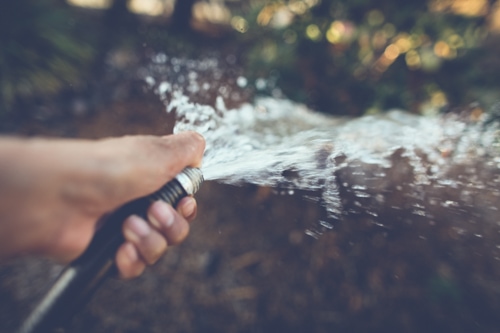
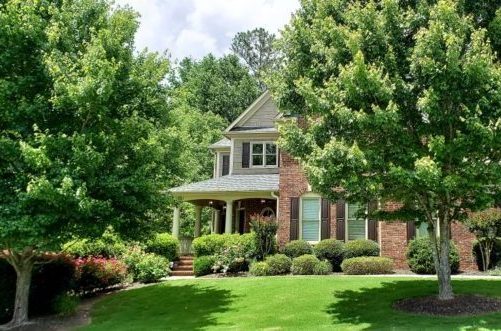
When it comes to watering your tree properly, it can be a bit tricky — as trees can suffer if you water too little or even if you water too much. So how can you tell if your tree is suffering from a lack or an excess of water? Unfortunately, signs of underwatering and overwatering your trees can be similar when it comes to the canopy and foliage, but do not stress because fortunately, there is a simple way to figure out which issue you have. The ground! Is it constantly damp or is it dry? Plain and simple.
UNDERWATERED TREE SYMPTOMS
- thinning canopy
- browning or yellowing of foliage (off-season fall colors)
- wilted or curling leaves
- untimely leaf drop
- dead branches
- small leaves
- slow growth
- pest infestation
Drought or underwatered trees are fairly easy to detect. For one, they don’t look healthy. The most obvious feature is that their canopy will be sparse, and their leaves will look an untimely fall color with wilting or curling. Then if you notice pests, it is definitely time to change your watering protocol and give your tree a nutrient boost through our Tree Health Care system.
When the tree’s drip zone (ground underneath the canopy) is devoid of water, the fine roots, which play an important role in water and nutrient absorption, begin to die back, thus affecting the health of the tree and displaying itself in the canopy and foliage. Eventually, if the tree continues to suffer from underwater stress, then the large, anchoring roots will dry up and die off as well. That’s when large trees become dangerous, as they become a likely candidate for tree failure.
OVERWATERED TREE SYMPTOMS
- frequent wet ground around the tree
- brittle leaves
- brown edges
- gray or black spotting on the leaves
- wilted or curling leaves
- yellowing or light green foliage
- untimely leaf drop
When a tree is receiving an excessive amount of water, the tree suffocates. Trees aide the planet with their ability to absorb carbon dioxide from the air and release fresh oxygen. But surprise, surprise — trees need oxygen too! The fine roots are also responsible for absorbing oxygen from tiny air pockets in the soil. If the tree is receiving too much water, water fills the air pockets, making it hard for the tree to breathe. The roots then produce methane, hydrogen, and nitrogen gases that choke out the roots, preventing them from performing their important duties for the tree.
HOW TO PROPERLY WATER YOUR TREE
HOW MUCH WATER FOR YOUR TREE
There’s a general rule of thumb for the amount of water to provide for your trees that may come as a shocker for most people — 10 gallons of water for every inch of trunk diameter! So if you do the math, a young tree with a skinny 2-inch trunk diameter that you just purchased from the nursery in a 5-gallon container needs 20 gallons of water according to that theory! Overkill? Possibly — although some arborists may argue otherwise. However, from our experience in the industry, as well as caring for our own personal trees, a newly-planted young tree does not need that hefty amount of water. So our verdict is…save your water!
As mentioned prior, you can learn how much water your tree needs by a simple screwdriver test. A majority of a tree’s roots sit in the top 12 inches of the ground, especially in urban settings where soil compaction and development can hinder deep root growth. When watering your tree, deep watering is the goal. And slow watering is the most efficient way to reach that goal. So provide enough water for your tree until your screwdriver, if you’re doing a screwdriver test, can easily be pushed all the way down. Then water a bit more, and then your tree will be a happy tree.
RECOMMENDED METHODS TO WATER YOUR TREE
Hose. Since trees require so much water, standing there with your hose will be extremely time-consuming. In addition, watering with the hose on high pressure will shower the tree with more water than the soil can absorb, which will result in wasted water run-off. A more efficient method in using a hose is to turn it on as low as possible so water is slowly dribbling out. After 20-30 minutes, move it to a new location under the canopy. Keep repeating until the tree’s drip zone has been sufficiently watered. Depending on the size of the tree, this may take 1-2 hours — so make sure to set your timer.
Soaker Hose. An easier and efficient method is using a soaker hose that is placed under the tree’s canopy. Soaker hoses are porous and allow water to slowly seep out. This gradual release of water minimizes wasted water and maximizes water absorption. The soaker hose should be placed in a circular pattern under the canopy of the tree and turned on for an hour or more. The goal is for the water to penetrate eight inches into the ground, which can easily be determined using the screwdriver test. Push an 8-inch screwdriver into the ground. If it pushes easily all the way, the ground is moist. Easy does it!
Dripline. The easiest method to watering your tree is using a drip irrigation system. However, it is also one of the most difficult to install. But once installation is complete, the rest is a no-brainer. Just like with a soaker hose, the dripline should be set in a circle under the canopy and run for an hour or more, contingent on factors such as the tree’s size, species, and climate.
Sprinkler. Sprinklers are another common system for watering landscape. Like the drip system, installation can be time-consuming and difficult, but once completed, the work is automatically performed for you and can be adjusted according to the tree and the season. Sprinklers are great for watering lawns and any area of land that is mostly covered with landscaping, however when they are used to water trees that are not heavily surrounded by other plants, then weeds will become an issue.
Bucket. If you need an easy method to water your tree that doesn’t require much time and doesn’t require the purchase of any additional “fancy” tools, you can always use the good ol’ 5-gallon bucket that is hanging out in your garage. Drill holes on the bottom portion of the bucket and place it in the tree’s drip zone. Fill the bucket with water and let it empty out. Then move the bucket to a new location, and repeat the previous step until the tree has received a sufficient amount of water.
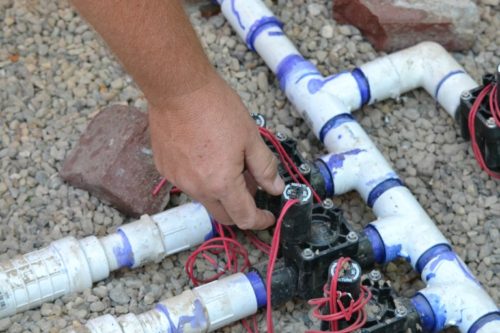

HOW OFTEN DOES YOUR TREE NEED TO BE WATERED?
Newly planted trees will require more water during the first 1-2 years. Their root structure is limited to a smaller area, and it needs to expand in order for the tree to thrive. However, when a tree is freshly transplanted, it undergoes a period of shock — which is why you may see leaf drop or signs of deterioration. Have no fear though. With proper care and patience, your tree will bounce back.
During the first two weeks after being planted, new trees need to be watered at least three times a week over the root ball, or even daily in dry, hot weather. Then, for the next ten weeks, this can be reduced to 1-3 times a week. For the rest of that first year up until the fifth year, the tree will need to be watered twice a month, or even weekly during times of heat or drought. For the first two years, water needs to be concentrated over the root ball. After that, the watering zone can be expanded to accommodate the growing root system.
YEAR ONE
Weeks 1+2
Weeks 3 -12
Rest of 1st Year
Water 3-7 times a week over the root ball.
Water 1-3 times a week depending on the weather over the root ball.
Water 2 times a month over the root ball.
YEAR TWO
Hotter Months
Colder Months
Water weekly or bi-weekly over the root ball.
Provide supplemental water when necessary.
YEAR THREE
Hotter Months
Colder Months
Water weekly or bi-weely to an area twice the width of the root ball.
Provide supplemental water when necessary.
Once a tree is established and mature, they will have such extensive roots that they are able to tap into deeper groundwater or may even creep into your neighbor’s property to take advantage of their water system. However, if it has not rained in at least a month, then supplemental water will still need to be provided. Remember that a water-deprived tree is weaker and susceptible to pests and disease, so keeping it as healthy as possible is key to its longevity.
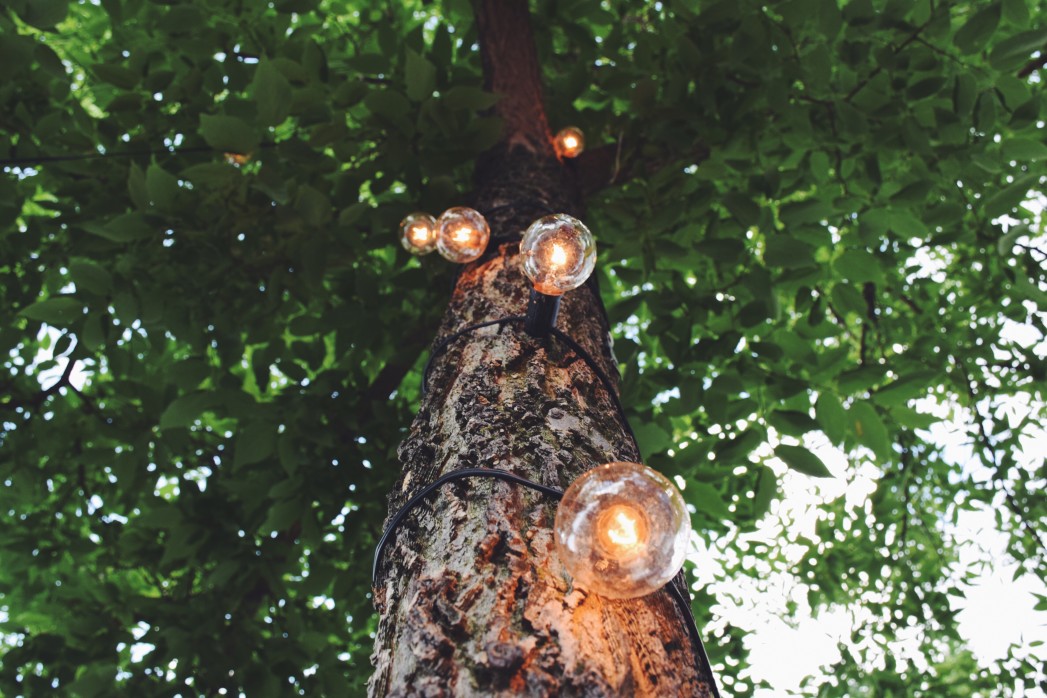
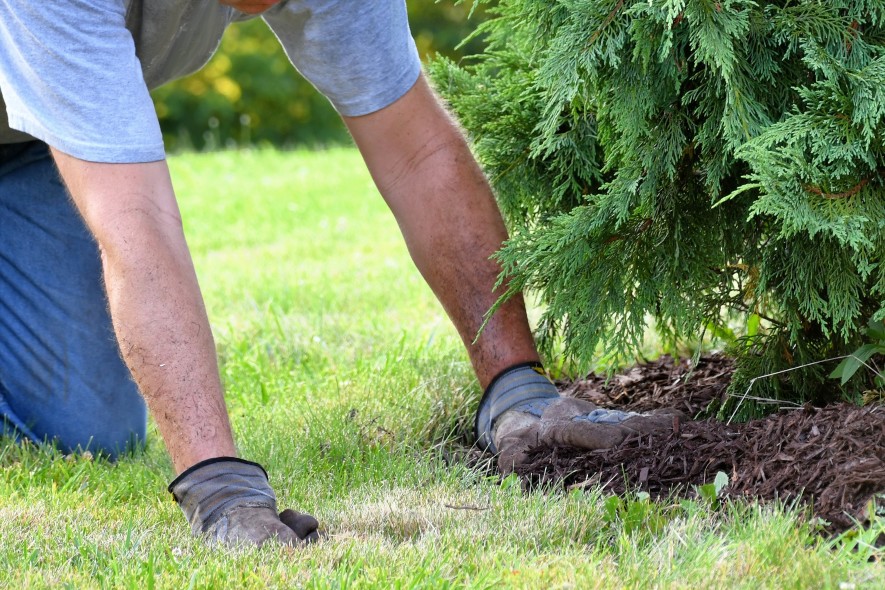
OTHER MEASURES TO HELP YOUR TREE
MULCH
Adding mulch as groundcover for your trees has many benefits that should not be overlooked. For starters, adding mulch helps prevent soil compaction by buffering the impact of water that can result from watering with a hose or from hard rain. Remember, trees get oxygen from tiny air pockets in the soil, so its important to keep the soil from getting too compacted. Mulch also acts like a layer of protection by helping to stabilize the ground temperature during extreme weather. During the hotter summer months, the ground will be slightly cooler, which results in less water evaporation and more comfortable roots. Happy roots, happy tree.
When applying mulch, it is important not to be too excessive. Trees only need 2-3 inches of mulch. Anything more will be asking for an array of problems, such as suffocation of the tree’s roots, wasted water, and a higher susceptibility to rodent pests and diseases. Therefore, avoid creating a mulch volcano. As the name implies, do not place down so much mulch that it ends up looking like a volcano around your tree.
CAMBISTAT
Cambistat is a plant health care additive developed by Rainbow Treecare Scientific Advancements that is quickly growing in popularity in the landscape and arboricultural industries. Cambistat was created primarily as a growth regulator, but it has several side results that are so beneficial for trees that people across the nation are raving about this product. Since the tree shifts its focus from above-ground growth, its energy is applied more towards underground growth with the roots, more specifically fine roots, which are primarily responsible for water, nutrient, and oxygen absorption. The end result is an overall healthier tree with greener foliage, increased resistance to disease, and increased resistance to heat and drought.
Even though Cambistat is a growth regulator, any size tree, big or small, would benefit from it. Many people use Cambistat to help control the size of their mature trees, but why would anyone use it on a young tree? Aren’t people anxious for a teeny, weeny, baby tree to grow to a large, lush adult tree? Yes, but remember that new transplants don’t grow much anyways the first two years after being planted so they could focus on root growth. Therefore, adding Cambistat during this period would be great timing so it could expedite the root growth process.
The effects of Cambistat can last for up to three years. After that time, you can choose to have it reapplied or skip reapplications so that a young tree can now refocus on trunk and limb growth. Either way, the tree will now have a stronger root system that is well set up for water absorption.
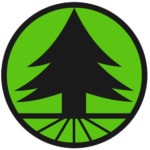
LOOKING FOR A TREE SERVICE COMPANY?
CONTACT LC TREE SERVICE TODAY FOR YOUR FREE ESTIMATE.

The post HOW TO WATER YOUR TREES PROPERLY first appeared on San Diego Tree Trimmers – LC Tree Service.
SOARING HEIGHTS WITH TREE TRIMMERS
Ever wonder what it feels like to be a professional tree trimmer? To be up a 100-ft palm swaying with the wind? Yikes! Or to sit atop a tree overlooking the neighborhood? To the adrenaline junkie or someone who abhors the thought of sitting at a desk for eight hours a day, being a tree trimmer is an ideal career. They get to hone in on their inner tree-climbing child for a living, but this time with menacing chainsaws and large trucks and equipment! It may a tiresome and dangerous career, but it sure is exciting!
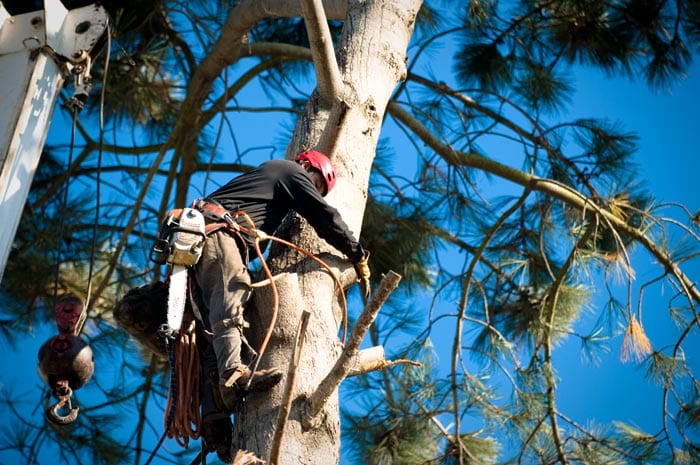
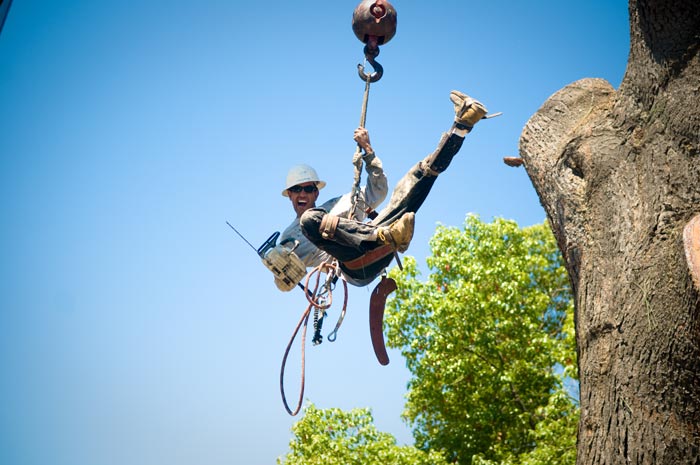
Do tree trimmers have a fear of heights?
When asked about a fear of heights, CEO, Larry Coalson, describes himself not NOT having a fear of heights, but rather a HEALTHY fear. Sitting 40 feet up in a tree doesn’t bother him the way it would your typical person. Even sitting at the edge of a cliff with a 200-ft drop doesn’t paralyze him with fear—unlike other people who get dizzy just thinking about it. Larry, on the other hand, views sitting on the edge of a cliff like sitting on a 10-ft wall. If you sit properly, your chances of falling are unlikely. BUT if you’re acting foolish, dancing along the edge, or just being plain dumb, then yes, you just might fall off!
Tree trimmers trust to some degree the trees that they climb onto. It doesn’t mean, however, that they trust all trees. Some trees can be too hazardous to climb, such as ones that are dead or rotting. Other trees could be too skinny and frail to give even a 50-lb child any sense of security, let alone a 180-lb man with a heavy chainsaw. This is why proper training and experience play a crucial role in keeping a tree trimmer safe, as well as the entire field crew and the property that the job is being performed at.
In San Diego, a couple of local trees that can make a grown man sweat with uncertainty are the lemon-scented eucalyptus and any tall Mexican fan palm whose crown is beyond the reach of a boom lift, so it therefore has to be climbed all the way to the top. Both of these trees (although technically, the fan palm isn’t a tree) grow tall and lanky—even known to soar past 100 feet in height. And not only are they tall, but they’re skinny and flexible. Bad combination for a tree trimmer, who couldn’t care less about swaying back and forth 60 feet up in the air on a tree trunk with a diameter of less than a foot. His only hope is that he’s not too heavy to cause it to snap.
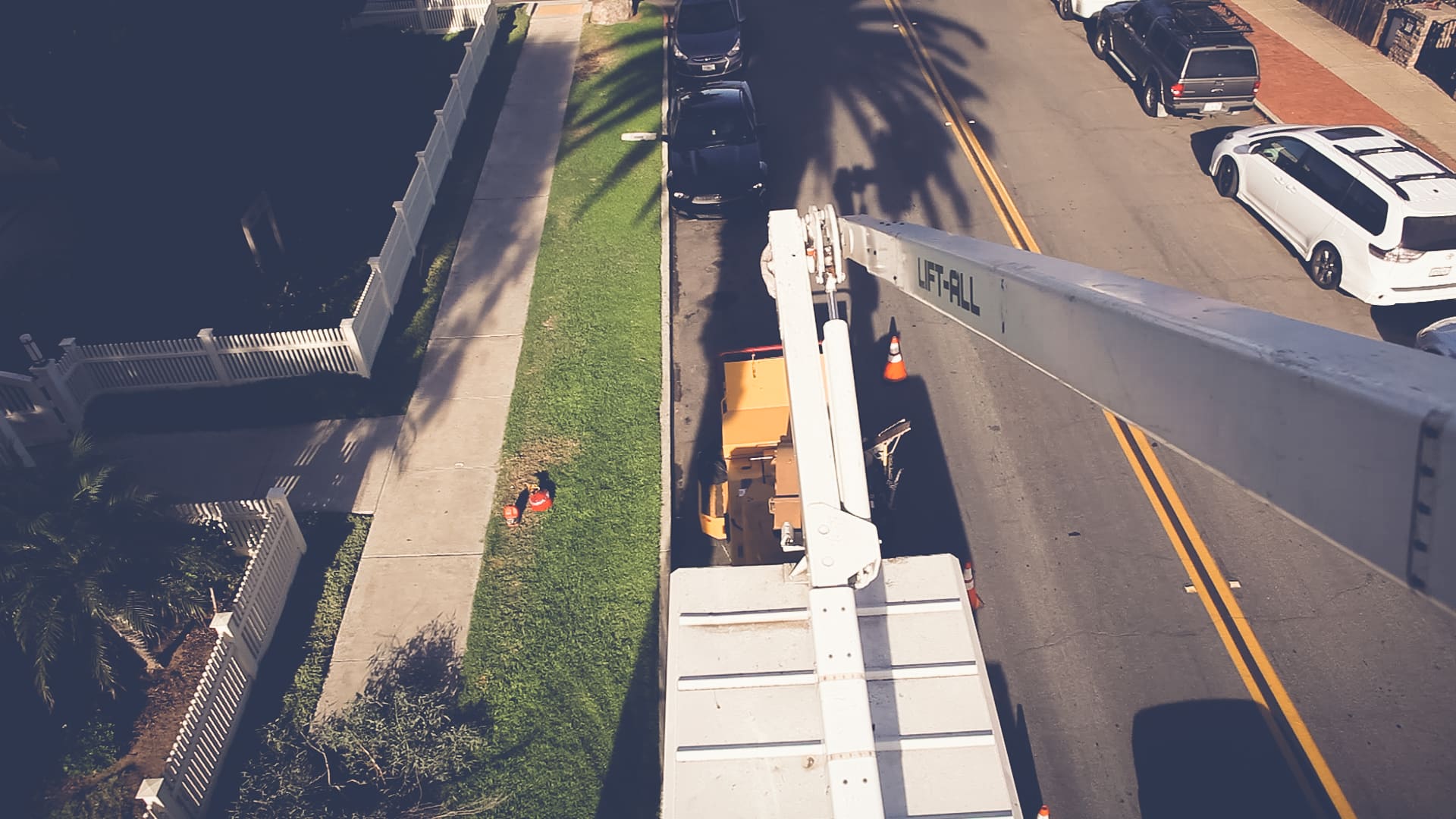
It’s a dangerous job—but someone has to do it!
Almost every tree trimmer goes through some degree of fear on the job—whether it be a minor uneasiness or a serious “I’m about to die!” terror. Practically every aspect of the job can be dangerous on a daily basis. Falling tree parts. Even worse…unexpected falling trees. Hazardous working heights. Dangerous chainsaws. Deadly chippers. Stabbing spikes that go right through the sole of a boot. Stinging bee armies. Electrical lines. And that’s just the tip of the iceberg.
According to the Bureau of Labor Statistics, the tree industry tops the nation’s list of the most dangerous jobs, with falling tree parts and equipment operation injuries being the main culprits for injuries and fatalities. It’s a dangerous job, but someone has to do it! But why would anyone want to put themselves at such risk on a daily basis? While Larry Coalson may not climb trees much anymore, back when he did climb for a living, he loved the daily adrenaline rush. The thought of sitting at a desk all day long made him cringe, but the thought of scaling up a tree for a living gave him a deep sense of excitement. The smell of the outdoors. The array of lurking dangers. The dangling heights that most people never get to experience. It all added to the love of his job—as dangerous as it was.
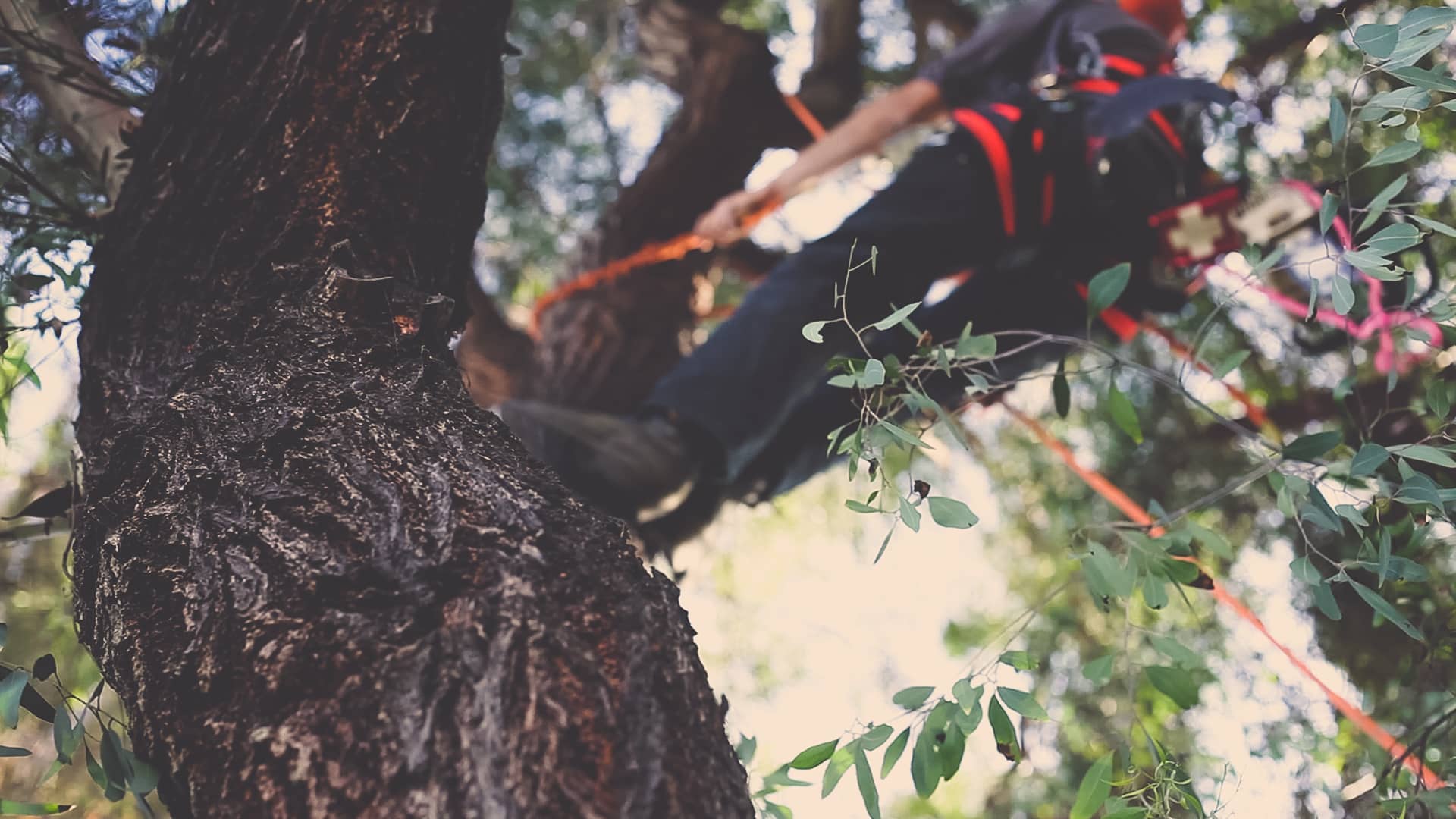
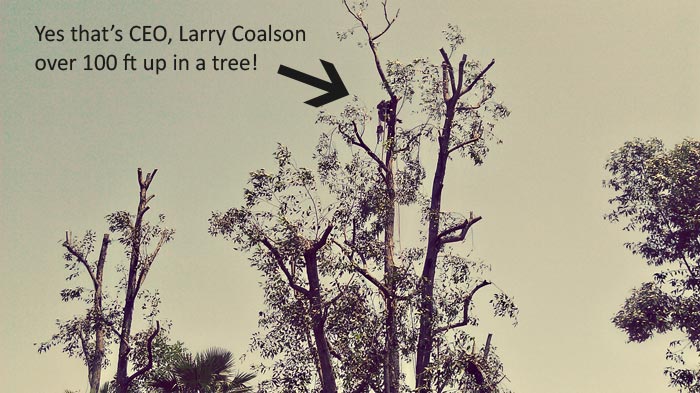
The post SOARING HEIGHTS WITH TREE TRIMMERS first appeared on San Diego Tree Trimmers – LC Tree Service.
IS YOUR TREE INFECTED OR INFESTED?
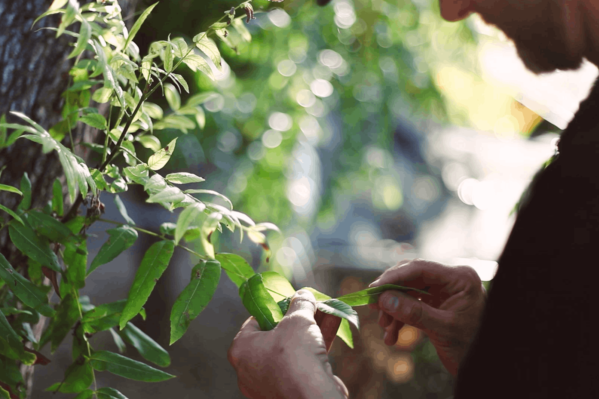
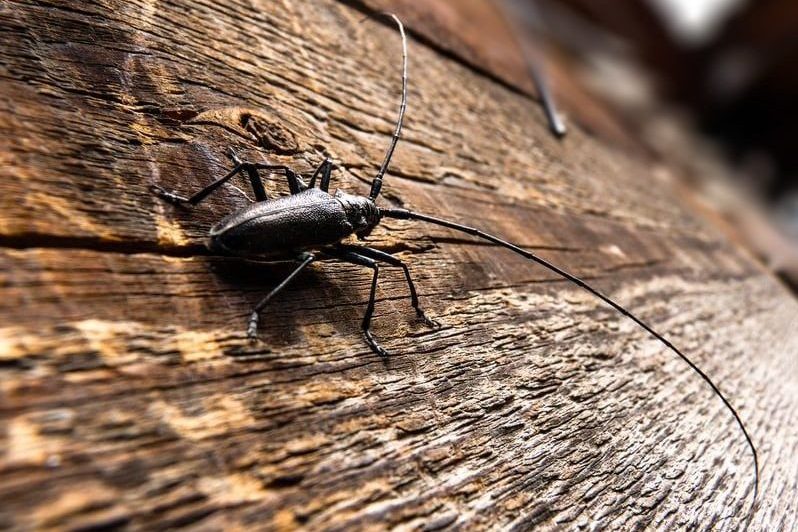
Trees can be a prized addition to any property, especially when they are large, mature, and well-maintained. Most people plant young, smaller trees on their property to save money and simply wait for the tree to grow to an ideal size, since transplanting a mature tree has a hefty price tag! Depending on the size of the tree, it can cost several $100,000. Yikes!
So when your cherished investment that you’ve been watching grow for the past 10 or 20 years starts to show signs of an infection or pest infestation, what should you do? IS there anything you can do to save your tree from further decline? The answer can be “yes” or “no.” The key is early detection. If an invading virus, bacteria, fungus, or pest has penetrated too deeply into the tree’s system, the extensive damage has been done and the only recommendation would be a tree removal. However, if the invaders are caught “red-handed” early on, then controlling, even eradicating them, is much more simple. Thankfully, there are several evident signs that you can look out for.
INFECTION + INFESTATION SIGNS
UNSEASONAL YELLOW OR BROWN FOLIAGE
When a tree is struggling with sickness or infestation, one of first signs that a property owner will notice is the change in the tree’s leaves. Nutrients are being robbed or nutrient absorption is hindered by the damage that is inflicted by the invaders. As a result, the tree’s foliage starts to die back and lose its color. This can be a tricky indicator source for an untrained eye, however, during the fall and winter months, since that is the time of the year when the leaves from deciduous trees naturally die off. Occasionally, we’ve received an inquiry from someone wanting their “dying” tree removed for safety concerns—when really it was winter, and the tree was simply doing what trees do in the winter. When deciduous trees start to go into hibernation, the discoloration in their foliage tends to spread throughout the entire canopy fairly quickly compared to that of an infested or infected tree. You should also note that evergreen trees shouldn’t have patches of browning foliage, as they are meant to stay green all year round. Therefore, using this indicator for evergreens, like pine trees, is more clear-cut than it would be for deciduous trees.

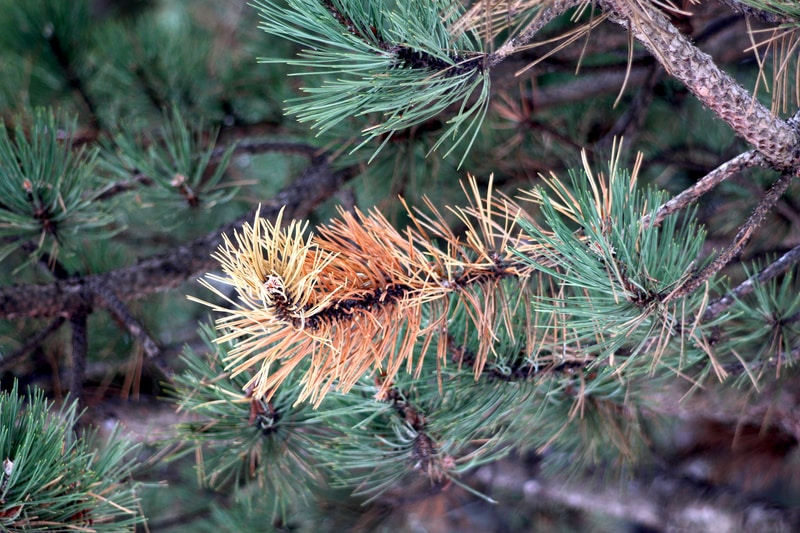
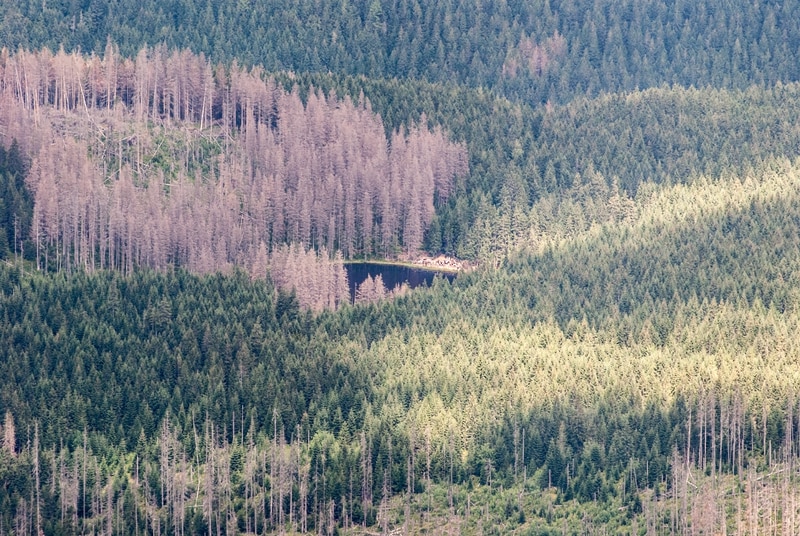
LEAKING TREE
Leakage from a tree is indicative of an injury, which could be a non-issue or a big issue. Anytime a tree loses a limb from a trimming or natural causes, it sustains an injury, which can cause it to bleed or leak sap. Typically, a tree will seal up its injuries—the same way our bodies heal up cuts. However, unlike the human body, trees do not heal—they seal. They do not repair the injury from the inside out, but instead compartmentalize the wound and form new callus tissue around and over the injury.
WETWOOD, or slime flux is a very common bacterial infection found in many trees. Oftentimes it can be found at the crotch of tree due to cracks in the wood or at a pruning site. But sometimes it be found just about anywhere on a tree. The bacteria makes its way into the heartwood and sapwood, typically through root injury. It, then, does its little thing, causing gas buildup. This increase in pressure pushes the sap out through any little crack or weak spot on the tree’s outer layers. Unfortunately, there are no known treatments for slime flux. But thankfully, it’s an infection that isn’t a big deal. Occasionally, it can have detrimental effects on an unhealthy tree—but for the majority of affected trees, it’s harmless.
BORING BEETLES are to blame for many sap leaks found in trees, especially in San Diego’s oaks and pines. Any tree that already has leaking sap is an easy target for these invaders, because it signals an easy entrance in, and it could also indicate that the tree has a weaker defense system. If beetles don’t enter through an already-existing wound, then they’ll eat their way through the bark to make a new home for their upcoming brood of cute little larva babies. Once the larvae are fully mature, they bore their way all the way out of the tree, leaving behind exit wounds or D-shaped holes. If the infestation is new, then the exist wounds may leak sap, which is still a good sign that the tree is still vivacious enough to try to defend itself. However, if a tree contains a number of dry holes that aren’t leaking, then it’s an unfortunate sign that the tree has been under attack for quite some time. The key to avoiding a beetle infestation from killing your tree is early detection. Spot a few holes, your tree may be okay. Spot more than a dozen, then contact LC Tree Service immediately for a consultation and possible treatment plan.
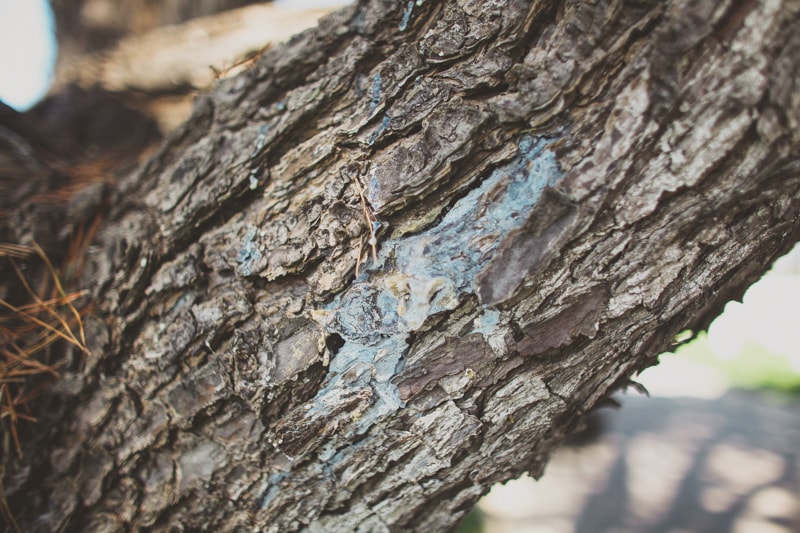
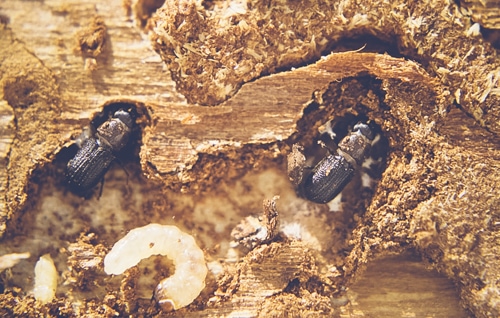
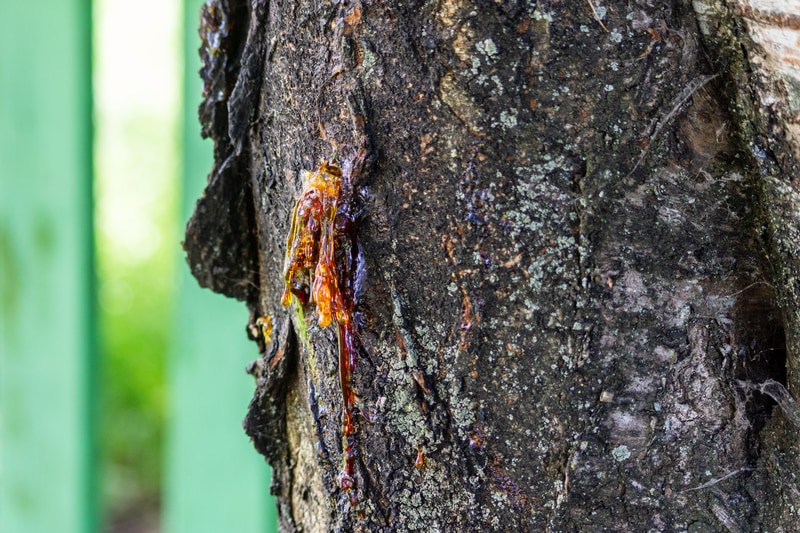
CONKS OR MUSHROOMS
Mushrooms on a plate of spaghetti—a great addition! Mushrooms at the base of a tree trunk—BAD!
Mushrooms, or conks, are the fruiting body of a fungus. While not all mushrooms are equally damaging to a tree, most are an external sign that something detrimental has already been going on internally or underground within the tree’s roots. Some fungi go directly for the roots, while others enter the tree through exterior wounds on the trunk or limbs that are caused by any number of sources, including tree trimming, cracks in the bark, blades from a lawnmower, or any other means of damage. Then the real impairment begins as the fungus releases an enzyme that breaks down the tree’s tissue to begin eating away at a seemingly unending source of food.
If the tree’s roots and/or base have been under fungal attack, then it makes the tree a likely candidate for breaking and falling—or what is known as tree failure. While fungicide treatments can slow down the spread of the fungus, in most cases where mushrooms are present (especially at the base), the tree is beyond repair due to the extensive internal damage that has already been done. If the foundation of the tree has been compromised, then unfortunately, the safest measure would be a tree removal.

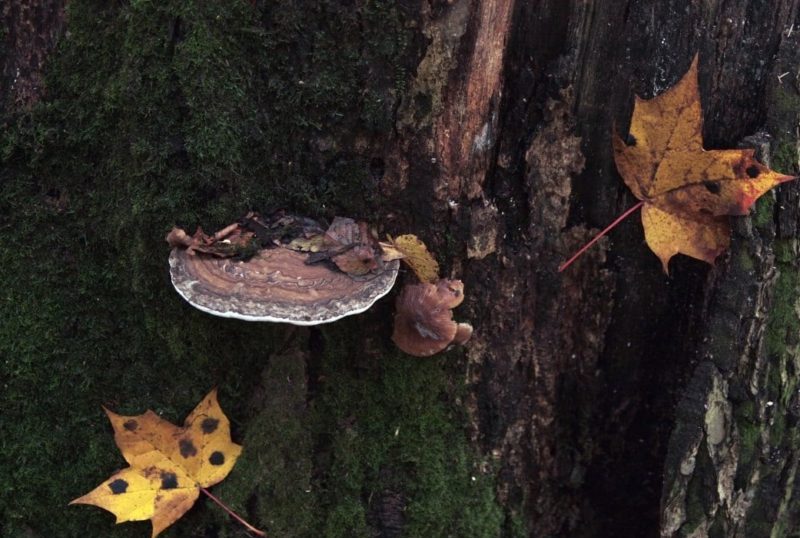
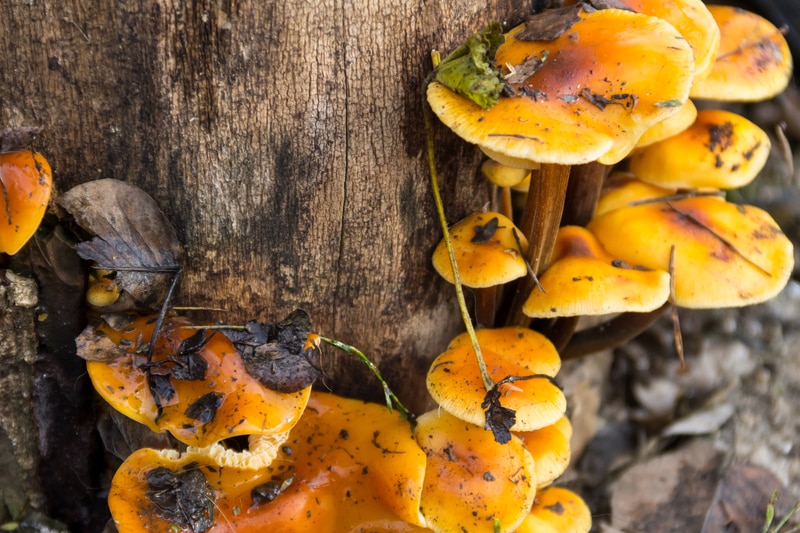
POWDERY MILDEW
If you notice a white powdery substance on your tree’s leaves, have no fear—it is a common fungal disease that is easy to remedy. The powder is the result of airborne fungal spores that spread with the wind to look for new trees to inflict. When a tree has been infected, white to grey fuzzy blotches appear not only on the leaves, but also on the stems and buds. This is a tree infection that is unavoidable in many parts of the world and can strike almost any tree. However, the most preferred tree species include oaks, dogwood, magnolia, maple, azaleas, lilacs, and crape myrtle.
The fungus thrives in humidity and in temperatures above 60 degrees—although it can still be found in arid climates as well. In the winter, it lies dormant, and it is awakened by the warmer spring temperatures. Growing season! New spores are produced in the dampness of the night, which are then carried off during the day by the wind. This process continues as long as the humidity levels and temperatures are high enough.
While the fungi that cause powdery mildew are hard to avoid, there are steps that you can take to prevent your trees from being infected.
- Plant trees in areas with plenty of sunshine to aide in keeping its foliage dry.
- Avoid wetting the foliage in the late afternoon.
- Keep trees well-trimmed to help increase air circulation and light penetration.
- Plant trees with plenty of space in between trees to help avoid cross-infection.
- If planting a new tree, consider a less-susceptible tree species.
Fortunately, this fungus is one that can be controlled with proper fungicide. Please contact us, if you notice leaf powder on your trees to avoid spread and leaf distortion.
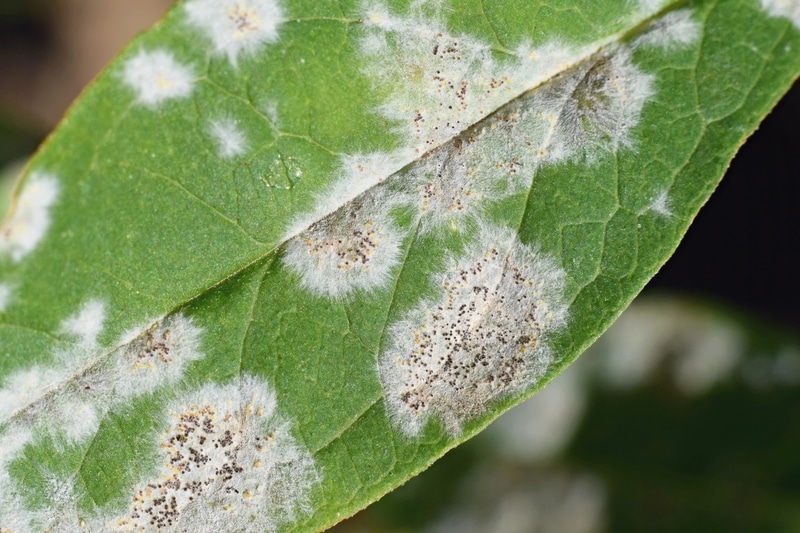
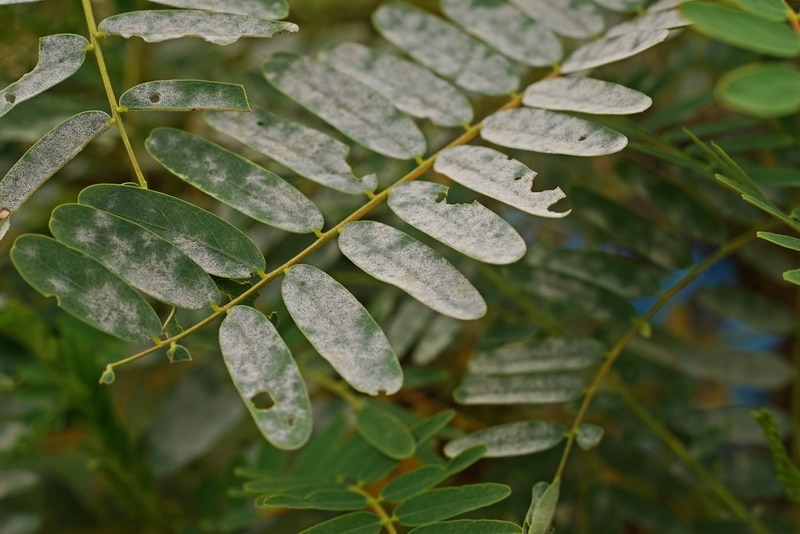

LOOSE BARK
All trees shed off their bark and crack to some degree. It’s simply their natural process of growing out of their skin. It could even just be the tree suffering from extreme elements, such as frost or extreme heat—in which some tender love and care to bring them back to a healthy state.
Some trees shed more than others, like the melaleuca tree that is so common to see in San Diego. This is a local tree that is ALWAYS shedding off its bark in a unique fashion that looks like paper peeling off, hence giving it its nickname—the paperbark tree. The various eucalyptus trees around the city are also notorious for molting. However, if a hardwood tree such as a pine has loose bark that comes off with a slight tug, then there is an underlying issue that should be inspected by a tree professional.
To better decipher whether your tree is going through its normal exfoliation process, look to see if there is a layer of fresh bark behind the shedding layer. If so, then that is a good sign that your is simply shedding. But if you see bare wood that has a fuzzy fungus or lighter-colered wiggly lines, then you have an issue. Your tree is suffering from either a fungal infection or a beetle infestation.
DISEASE. A common culprit for peeling bark on trees is a fungal disease called Hypoxylon canker. Its most popular victim is the oak tree, although different
Hypoxylon species will affect different host trees of choice. Being a fungus, it spreads through aerial spores, but will only cause harm to weak and stressed trees that are easy prey. Healthy trees typically have no issue defending themselves against Hypoxylon. In fact, many healthy trees already have the fungus on their outer bark, but they won’t be affected unless their natural defense mechanisms are compromised by factors such as malnutrition, drought, heat, insect attacks, etc.
Unfortunately, there is no known cure for Hypoxylon canker. Because the fungus lives in the interior of a tree, once the infection become evident from the outside, the irreversible damage has already been done. The typical protocol would be a removal of infected limbs or removal of the entire tree, especially if the fungus has affected the trunk.
BEETLE INFESTATIONS are a common cause for loose bark, especially with the pines in San Diego. The beetles feed mainly on the tree’s sapwood located just beneath the bark. This eventually causes the bark to loosen up and fall. Boring holes in the trunk are a tell-tale sign that the tree is infected with beetles, but for curiosity’s sake, if you wish to see their burrows, you can try peeling off a section of the bark—which will uncover a chaotic mess of the beetles’ burrowing lines. Take note though that if you are able to peel off the bark that easily, then the tree is beyond saving.
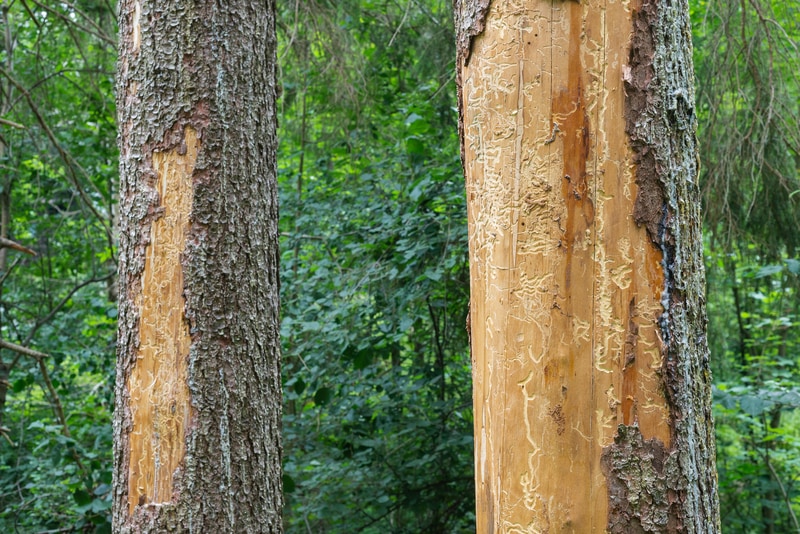
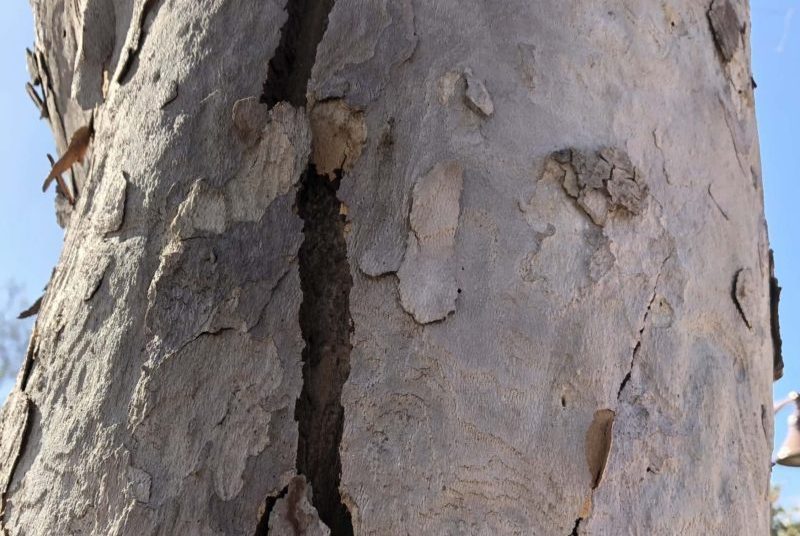
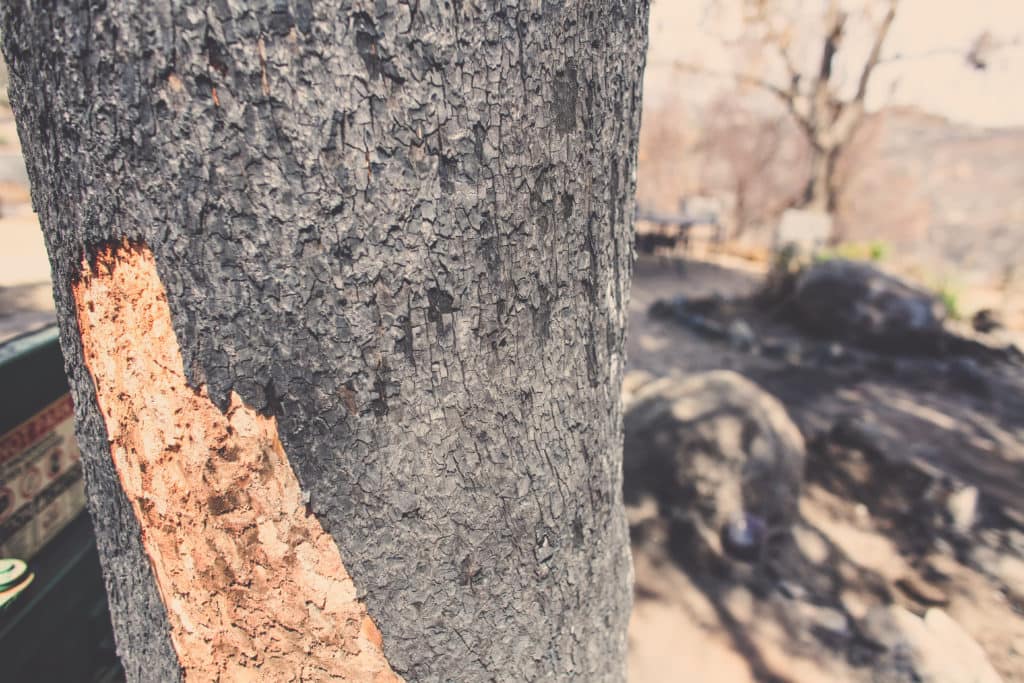
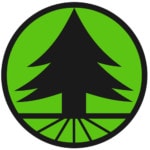
IF YOU HAVE AN INFESTED OR INFECTED TREE,
PLEASE CONTACT LC TREE SERVICE IMMEDIATELY
SERVING ALL OF SAN DIEGO COUNTY
The post IS YOUR TREE INFECTED OR INFESTED? first appeared on San Diego Tree Trimmers – LC Tree Service.
